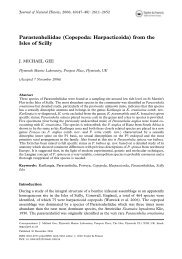An Updated Classification of the Recent Crustacea
An Updated Classification of the Recent Crustacea
An Updated Classification of the Recent Crustacea
You also want an ePaper? Increase the reach of your titles
YUMPU automatically turns print PDFs into web optimized ePapers that Google loves.
<strong>An</strong> <strong>Updated</strong> <strong>Classification</strong> <strong>of</strong> <strong>the</strong> <strong>Recent</strong> <strong>Crustacea</strong><br />
By JOEL W. MARTIN 1 AND GEORGE E. DAVIS 1<br />
ABSTRACT. <strong>An</strong> updated classification <strong>of</strong> <strong>the</strong> <strong>Crustacea</strong> down to <strong>the</strong> level <strong>of</strong> family is<br />
provided. The classification is based loosely on that given by Bowman and Abele (1982)<br />
and includes all new families and higher level taxa described since that time. In addition,<br />
in several crustacean groupings, new arrangements and assignments have been incorporated,<br />
based usually on phylogenetic information that has accrued or that has become<br />
more widely accepted since 1982. Among <strong>the</strong> more salient changes, some <strong>of</strong> which are<br />
more controversial than o<strong>the</strong>rs, are <strong>the</strong> recognition <strong>of</strong> <strong>the</strong> former phylum Pentastomida<br />
as a group <strong>of</strong> maxillopod crustaceans based on additional spermatological and molecular<br />
evidence, <strong>the</strong> inclusion <strong>of</strong> <strong>the</strong> parasitic Tantulocarida also among <strong>the</strong> maxillopods, <strong>the</strong><br />
treatment <strong>of</strong> <strong>the</strong> Branchiopoda as <strong>the</strong> most primitive extant group <strong>of</strong> crustaceans, and<br />
<strong>the</strong> recognition <strong>of</strong> Guinot’s (1977, 1978) division <strong>of</strong> <strong>the</strong> higher (eubrachyuran) crabs<br />
into two ‘‘grades’’ based primarily on placement <strong>of</strong> <strong>the</strong> genital aperture. The revised<br />
classification includes 849 extant families in 42 orders and 6 classes; this is an increase<br />
<strong>of</strong> nearly 200 families since <strong>the</strong> Bowman and Abele classification. More than 90 specialists<br />
in <strong>the</strong> field were consulted and asked to contribute to <strong>the</strong> update. Some workers<br />
are not in agreement with our final arrangement. In particular, <strong>the</strong>re are questions or<br />
dissenting opinions over our choice <strong>of</strong> which taxa to recognize, which authorities and<br />
dates to credit for various taxa, and especially over <strong>the</strong> arrangements among and/or<br />
within <strong>the</strong> higher taxa. As an aid to future workers in crustacean classification and<br />
phylogeny, comments and dissenting opinions <strong>of</strong> some <strong>of</strong> <strong>the</strong>se workers are appended<br />
to highlight areas <strong>of</strong> uncertainty or controversy. Also appended are a list <strong>of</strong> <strong>the</strong> specialists<br />
who were given <strong>the</strong> opportunity to respond (Appendix II) and a list <strong>of</strong> printed and<br />
World Wide Web resources that contain information on crustaceans (Appendix III). The<br />
new classification is in part a result <strong>of</strong> one such site, <strong>the</strong> <strong>Crustacea</strong>n Biodiversity Survey<br />
(formerly found at URL http://www.nhm.org/cbs/, now temporarily <strong>of</strong>f-line).<br />
GENERAL INTRODUCTION<br />
No group <strong>of</strong> plants or animals on <strong>the</strong> planet exhibits<br />
<strong>the</strong> range <strong>of</strong> morphological diversity seen among<br />
<strong>the</strong> extant <strong>Crustacea</strong>. This morphological diversity,<br />
or disparity in <strong>the</strong> paleontological jargon, is what<br />
makes <strong>the</strong> study <strong>of</strong> crustaceans so exciting. Yet it is<br />
also what makes deciphering <strong>the</strong> phylogeny <strong>of</strong> <strong>the</strong><br />
group and ordering <strong>the</strong>m into some sort <strong>of</strong> coherent<br />
classification so difficult. Because <strong>of</strong> <strong>the</strong> great age<br />
<strong>of</strong> <strong>the</strong> group, extending back at least as far as <strong>the</strong><br />
early Cambrian and almost certainly beyond that,<br />
<strong>the</strong>re has been ample time for endless experimentation<br />
with form and function. The result <strong>of</strong> <strong>the</strong>se<br />
many millions <strong>of</strong> years <strong>of</strong> evolution is quite dazzling.<br />
The current estimate <strong>of</strong> <strong>the</strong> number <strong>of</strong> described<br />
species is approximately 52,000 (Land,<br />
1996; Monod and Laubier, 1996). This estimate is<br />
surely on <strong>the</strong> low side, as a recent estimate <strong>of</strong> <strong>the</strong><br />
1<br />
Natural History Museum <strong>of</strong> Los <strong>An</strong>geles County, Research<br />
and Collections, Department <strong>of</strong> Invertebrate Zoology,<br />
900 Exposition Boulevard, Los <strong>An</strong>geles, California<br />
90007<br />
Email: jmartin@nhm.org and gdavis@nhm.org<br />
number <strong>of</strong> living species <strong>of</strong> ostracodes alone is<br />
10,000 to 15,000 (K. Martens, pers. comm., and<br />
discussions on <strong>the</strong> electronic ostracode listserver<br />
OSTRACON@LISTSERV.UH.EDU) and Kensley<br />
(1998) has estimated more than 54,000 for <strong>the</strong> reefassociated<br />
peracarids. Among <strong>the</strong> Metazoa, <strong>the</strong> estimate<br />
<strong>of</strong> 52,000 species places crustaceans fourth,<br />
behind insects, molluscs, and chelicerates, in terms<br />
<strong>of</strong> overall species diversity. But morphological diversity<br />
(disparity) is higher in <strong>the</strong> <strong>Crustacea</strong> than in<br />
any o<strong>the</strong>r taxon on Earth. There are probably few<br />
o<strong>the</strong>r groups <strong>of</strong> animals (squids come to mind because<br />
<strong>of</strong> Architeuthis) in which <strong>the</strong> difference in<br />
maximum size <strong>of</strong> adults can be a factor <strong>of</strong> 1,000.<br />
The known size <strong>of</strong> crabs now ranges from a maximum<br />
leg span <strong>of</strong> approximately 4min<strong>the</strong>giant<br />
Japanese spider crab Macrocheira kaempferi and a<br />
maximum carapace width <strong>of</strong> 46 cm in <strong>the</strong> giant<br />
Tasmanian crab Pseudocarcinus gigas (as cited in<br />
Schmitt, 1965) to a minimum <strong>of</strong> 1.5 mm across <strong>the</strong><br />
carapace for a mature ovigerous female pinno<strong>the</strong>rid,<br />
Nanno<strong>the</strong>res moorei, <strong>the</strong> smallest known spe-











